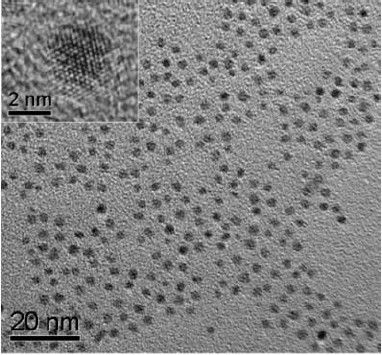Highlight fept
Magnetic Nanoparticles
There have been incredible advances in hard disk drive technology over the past few decades and state of the art drives can now store in excess of 100 Gb/in2. With current materials, however, we are rapidly approaching the so called superparamagentic limit whereby as the size of grains used to store information is decreased, thermal energy becomes sufficient to randomise magnetic information.
One solution to this problem is to use a material such as FePt which has a high magnetocrystalline anisotropy. Calculations show that nanoparticles of the crystallographically ordered L10 phase of FePt as small as 3 nm are potentially suitable for long term data storage. If a single bit of magnetic information can be stored on an individual nanoparticle huge increases in areal density could be achieved.
We have recently published a new synthetic route to FePt particles. This relies on using formally Fe(2-) ions to reduce Pt(2+) ions. In contrast to other methods this ensures a high control over particle stoichiometry and intimate mixing of Fe and Pt on an atomic lengthscale.
We’ve been able to produce particles with a narrow size dispersion and tight control over their size. We’ve also been able to prepare the crystallographically ordered L10 phase directly in solution. This work was recently highlighted in chemistry world.

The crystal structures of fcc disordered and fct ordered FePt.

TEM image of individual fcc FePt nanoparticles.
Further details of this work can be found in the publications below. We thank the UIC for funding.
“Synthesis of size controlled fcc and fct FePt nanoparticles by microwave irradiation”, H.L. Nguyen, L.E.M. Howard, S.R. Giblin, B.K. Tanner, I. Terry, A.K. Hughes, I.M. Ross, A. Serres, H. Burckstummer, J.S.O. Evans, Journal of Materials Chemistry, 15, 2005, 5136-5143.
“A synthetic route to size-controlled fcc and fct FePt nanoparticles”, L.E.M. Howard, H.L. Nguyen, S.R. Giblin, B.K. Tanner, I. Terry, A.K. Hughes, J.S.O. Evans, Journal of the American Chemical Society, 127, 2005, 10140-10141.
